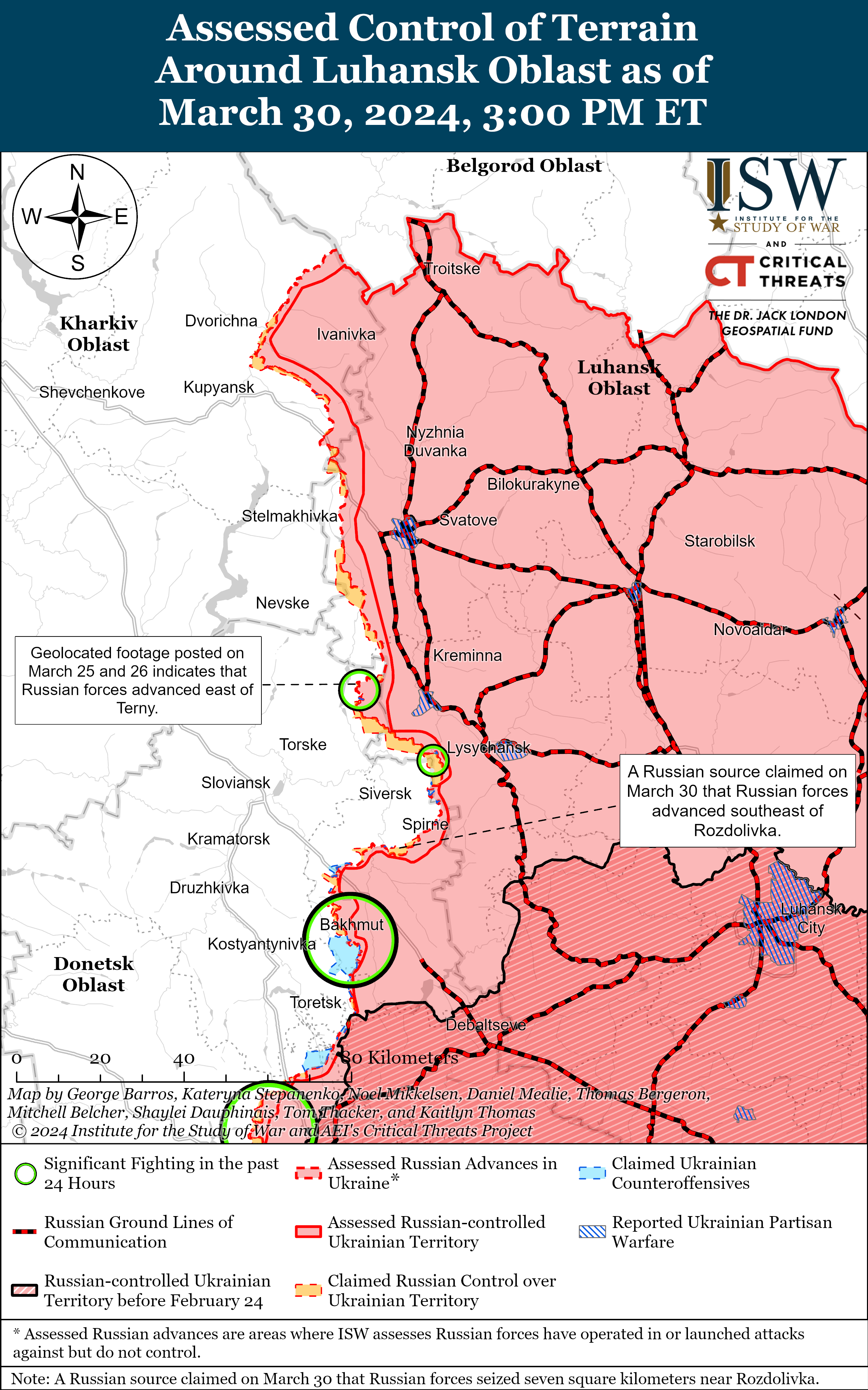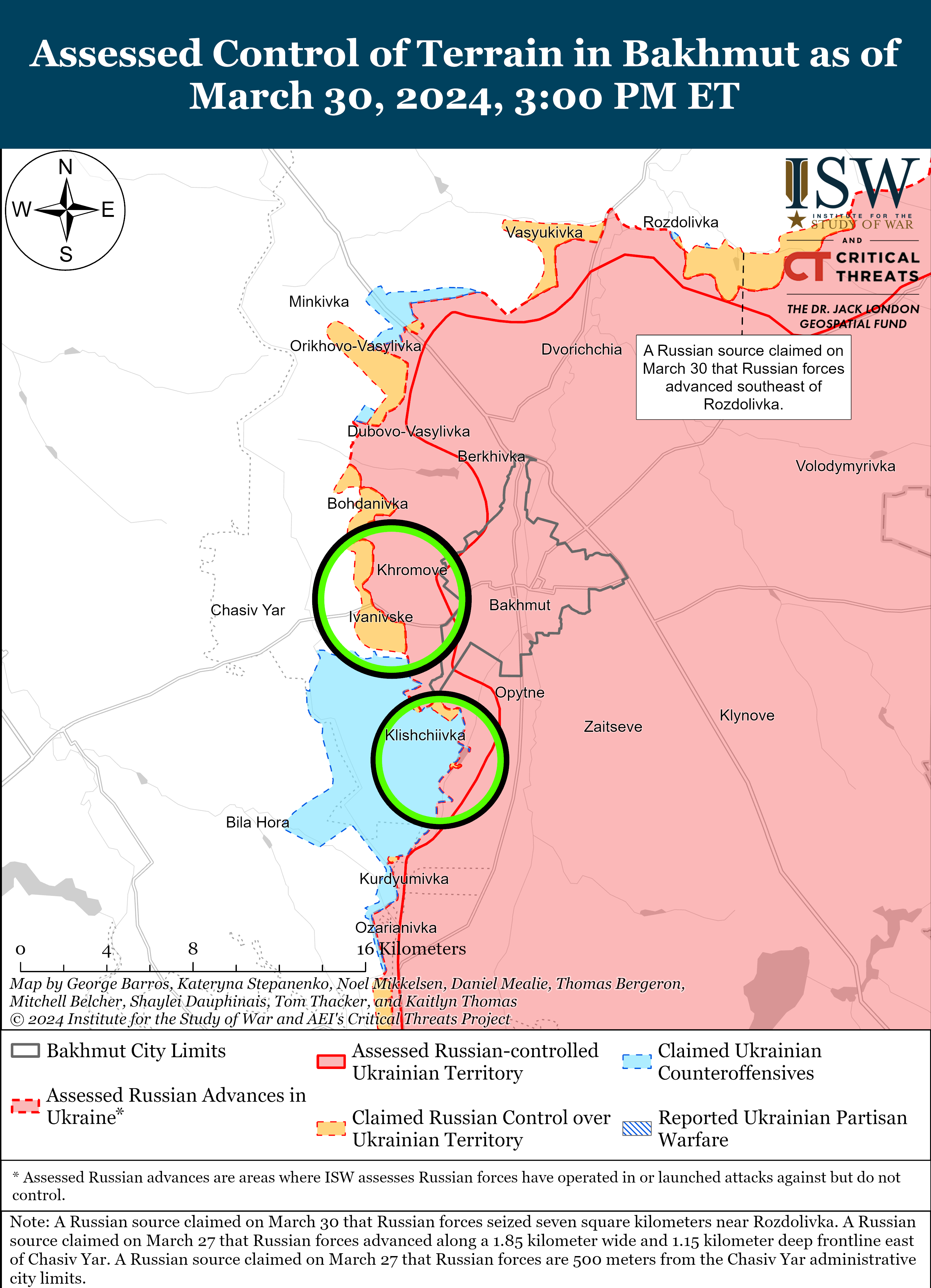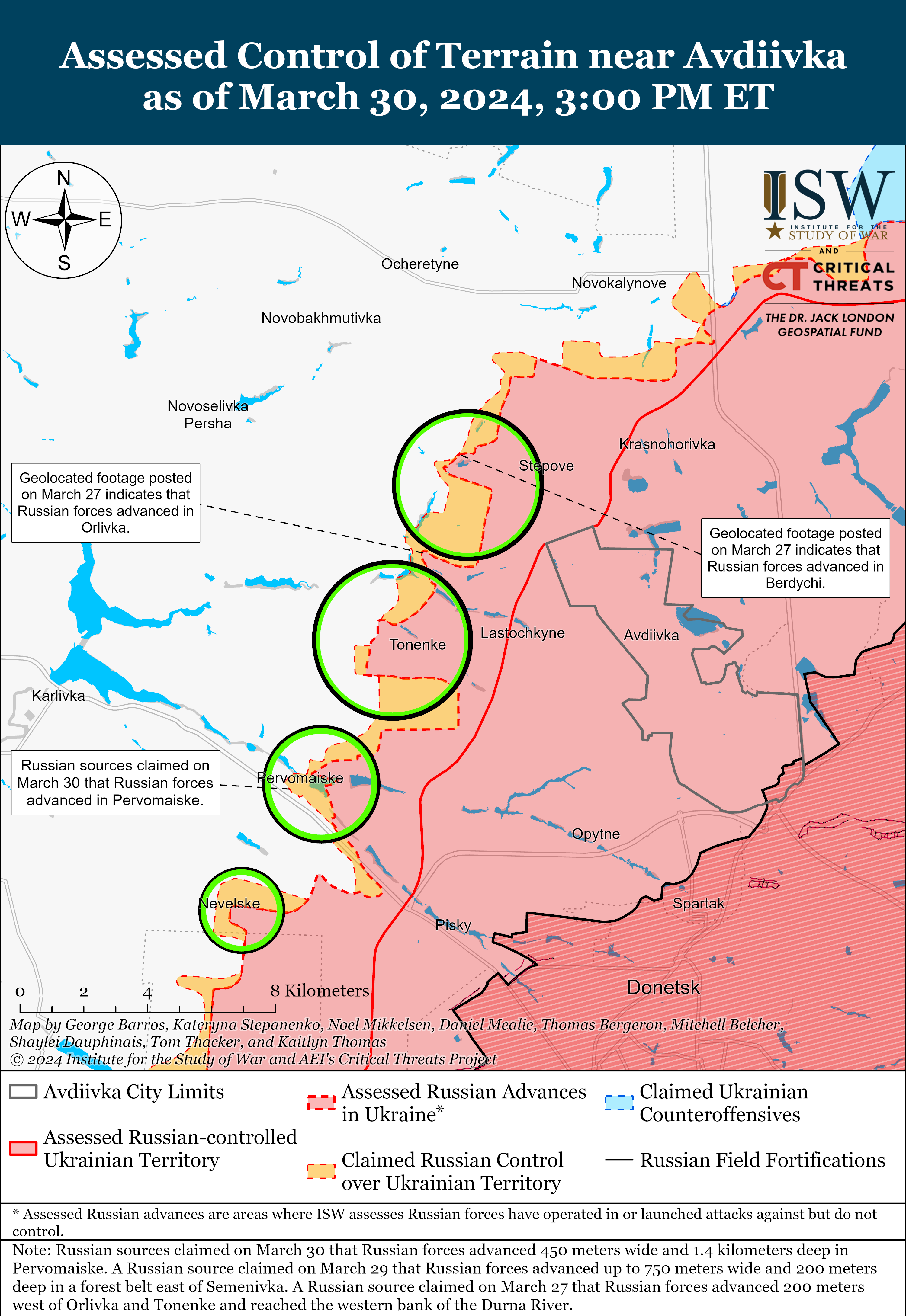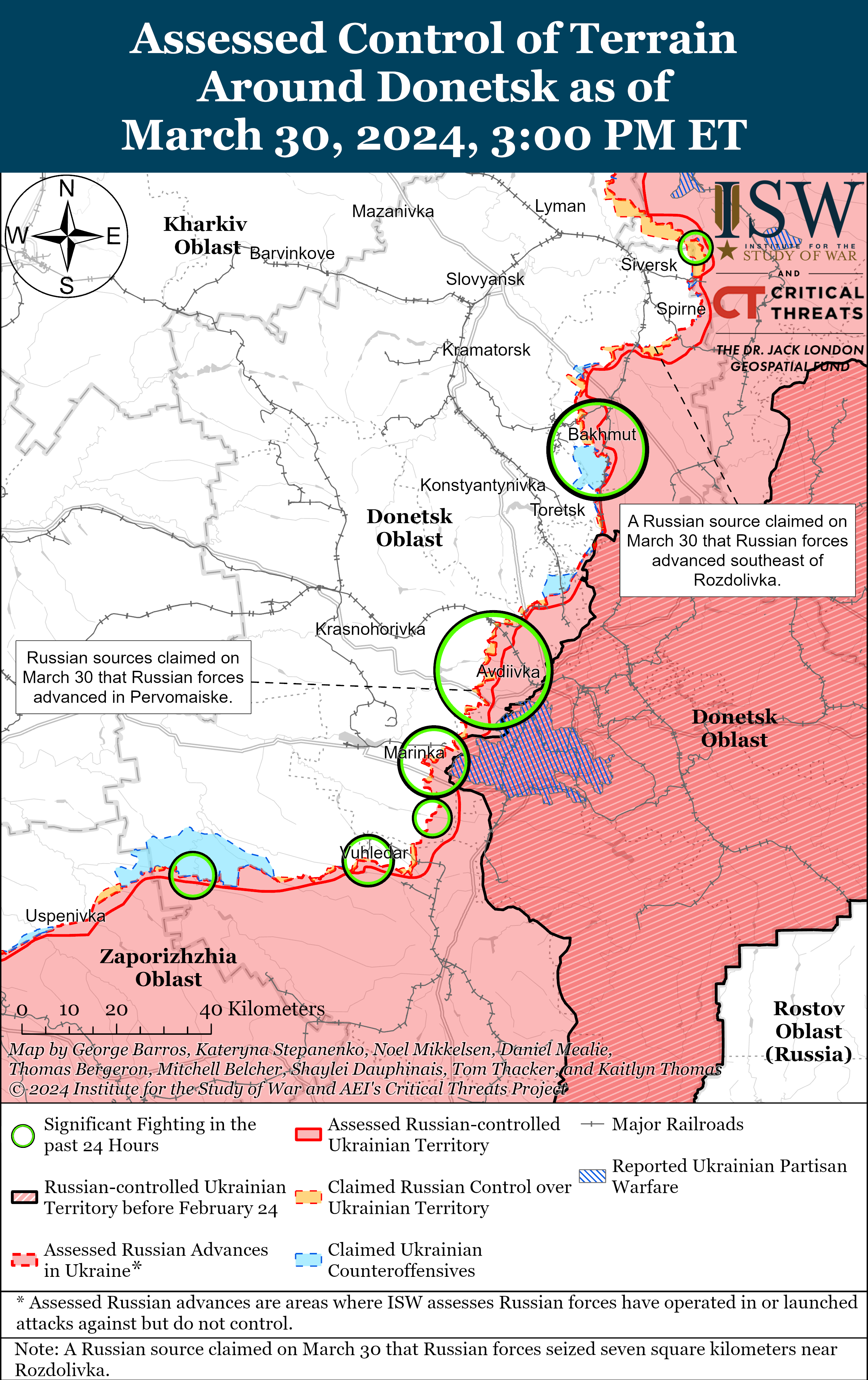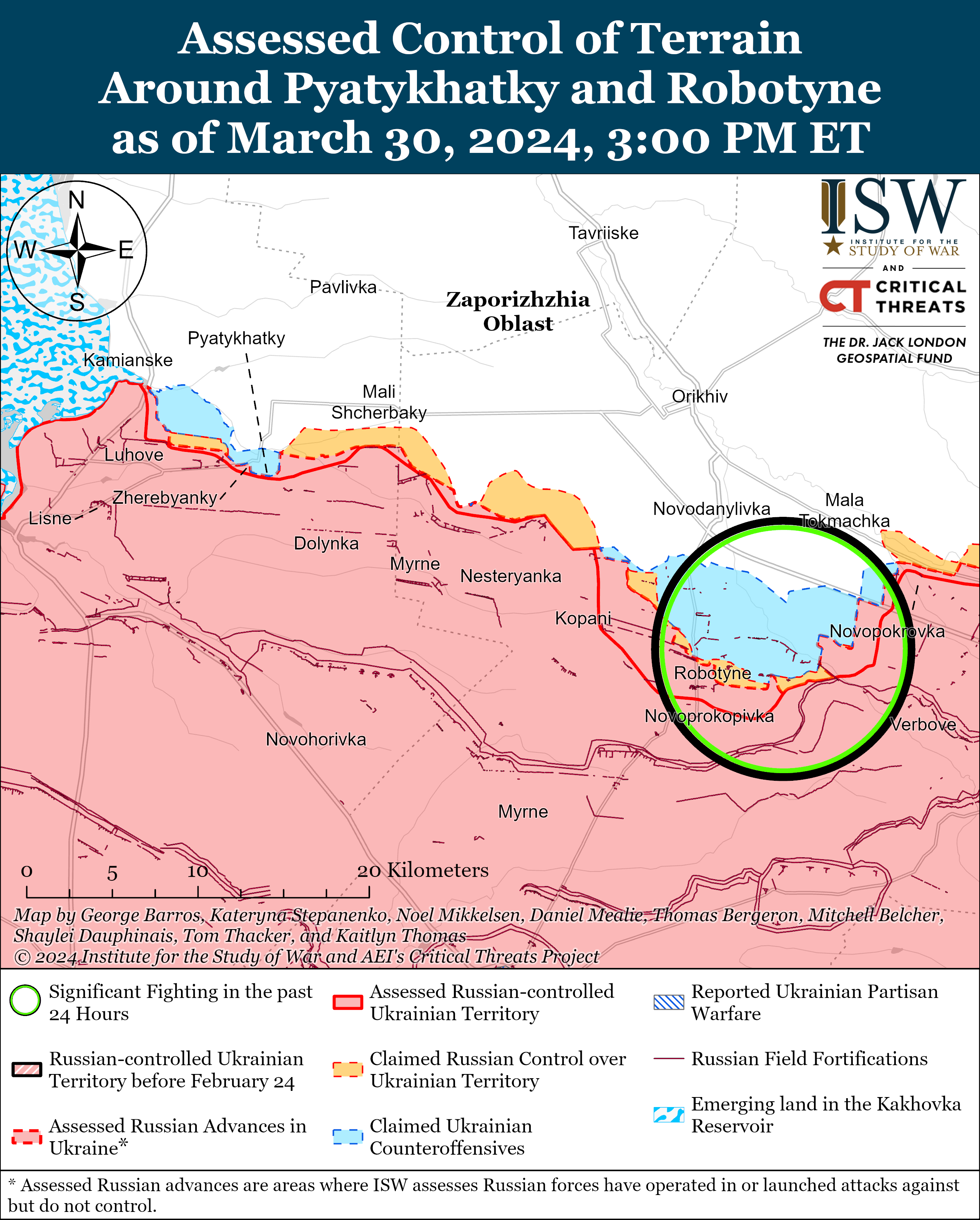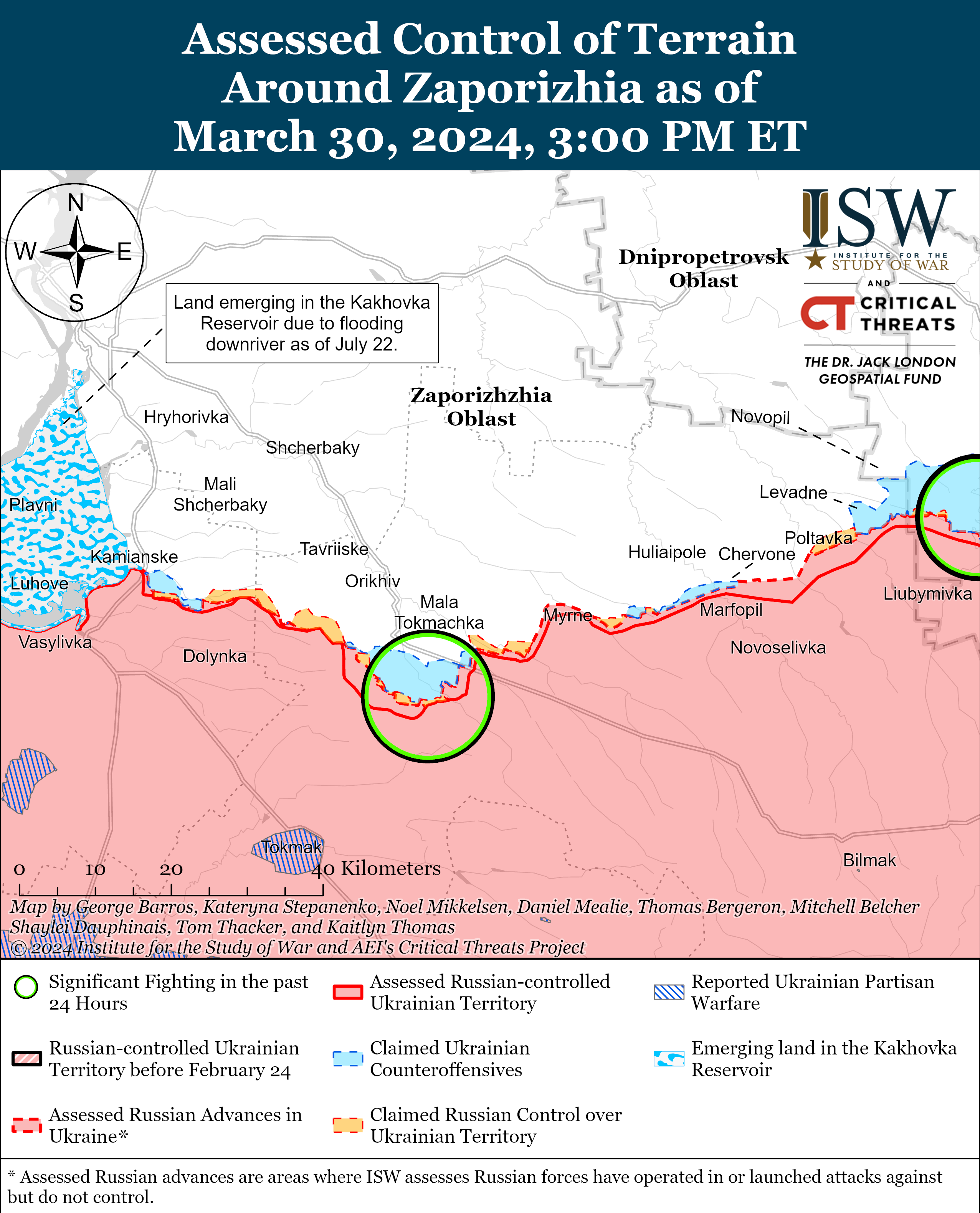Riley Bailey, Grace Mappes, Angelica Evans, Kateryna Stepanenko, and George Barros
March 30, 2024, 6:55pm ET
Click here to see ISW’s interactive map of the Russian invasion of Ukraine. This map is updated daily alongside the static maps present in this report.
Click here to see ISW’s 3D control of terrain topographic map of Ukraine. Use of a computer (not a mobile device) is strongly recommended for using this data-heavy tool.
Click here to access ISW’s archive of interactive time-lapse maps of the Russian invasion of Ukraine. These maps complement the static control-of-terrain map that ISW produces daily by showing a dynamic frontline. ISW will update this time-lapse map archive monthly.
Note: The data cut-off for this product was 1:30pm ET on March 30. ISW will cover subsequent reports in the March 31 Russian Offensive Campaign Assessment.
Ukrainian President Volodymyr Zelensky indicated that delays in American security assistance have forced Ukraine to cede the battlefield initiative and that these delays continue to threaten Ukraine’s defensive capabilities. The Washington Post published excerpts of an interview with Zelensky on March 29 in which Zelensky stated that Ukraine will not be able to defend its territory without American support, as Ukraine currently relies on air defense systems and missiles, electronic warfare jammers, and 155mm artillery shells from the United States.[1] Zelensky stated that continued materiel shortages will force the Ukrainian military to cede more Ukrainian territory and people “step by step” since a smaller but more stable frontline is preferable to a larger but unstable front that Russian forces could exploit to achieve a breakthrough. Zelensky stated that Ukrainian forces are “trying to find some way not to retreat” from unspecified frontline areas and noted that Ukrainian forces have stabilized the front near Avdiivka, Donetsk Oblast. Zelensky reiterated that the Ukrainian military’s planning ability to make decisions is contingent on US military assistance and that Ukraine cannot plan counteroffensive efforts without knowing whether Ukraine will receive US military assistance, and what future US military assistance will entail. Zelensky warned that Russia will exploit any future scenarios in which Ukraine must cede the initiative: “If you are not taking steps forward to prepare another counteroffensive, Russia will take [these steps].” Zelensky also stated that Ukraine has learned that “if you don’t do it, Russia will do it.” Zelensky also indicated that Ukraine is conducting rear-area strikes against Russian oil refineries to generate strategic effects as Ukraine cannot plan for or conduct counteroffensive operations without more information about US military assistance. Zelensky stated that Ukrainian strikes against Russian oil refineries and other strategic targets are in response to Russian strikes against Ukrainian energy infrastructure. Zelensky’s interview is consistent with Ukrainian Commander-in-Chief Colonel General Oleksandr Syrskyi’s recent statements that delays in Western military assistance are constraining Ukrainian forces and that Ukrainian forces are not able to completely compensate for battlefield shortcomings caused by material shortages.[2]
Russian missile strikes destroyed one of the largest thermal power plants in Kharkiv Oblast on March 22, as continued delays in US security assistance degrade Ukraine’s air defense umbrella and increase Russia’s ability to significantly damage Ukraine’s energy grid. Ukrainian electric company Tsentrenergo reported on March 29 that Russian missile strikes destroyed all power units and auxiliary equipment at the Zmiivska Thermal Power Plant (TPP) in Kharkiv Oblast on March 22.[3] Russian forces conducted the largest series of combined drone and missile strikes targeting Ukrainian energy infrastructure on the night of March 21 to 22 since the start of the full-scale invasion and have since heavily targeted Ukrainian energy infrastructure, including hydroelectric power plants (HPPs).[4] Russian strikes against Ukrainian energy facilities may aim to degrade Ukrainian defense industrial capacity, and Russian forces are likely trying to exploit Ukraine’s degraded air defense umbrella to collapse Ukraine’s energy grid.[5] The Washington Post reported on March 29 that Ukraine’s largest private energy company DTEK stated that Russian drones and missiles are increasingly penetrating Ukraine’s air defense, and that more accurate and concentrated Russian strikes are inflicting greater damage against Ukrainian energy facilities.[6] Previous Russian strikes have recently rendered other Ukrainian energy facilities inoperable before, but the complete destruction of a TPP is rare and notable, and the recently accelerated degradation of Ukraine’s energy generation capabilities, if gone unchecked, will likely constrain Ukraine’s ability to stabilize future disruptions to its energy grid in the long term.[7]
Russian forces are demonstrating technological and tactical adaptations and are increasingly using unmanned ground vehicles (UGVs) on the frontlines of Donetsk Oblast. Russian and Ukrainian sources amplified footage on March 29 and 30 showing Ukrainian forces striking Russian unmanned ground vehicles in southeastern Berdychi (northwest of Avdiivka) and in the Bakhmut direction.[8] Russian milbloggers claimed that these UGVs are equipped with AGS-17 grenade launcher systems, which reportedly can fire 50 to 400 grenades per minute.[9] Russian sources also amplified footage of other Russian small wheeled and tracked unmanned ground drones operating in unspecified areas, which Center for Naval Analyses (CNA) expert Samuel Bendett assessed to be involved in intelligence surveillance and reconnaissance (ISR), logistics, personnel evacuations, and light combat roles.[10] The US and NATO should study the rapidly evolving battlefield in Ukraine to develop a deeper understanding of the future of warfare and the characteristics of future warfare.
The Russian military is reportedly forming mobile fire groups to mitigate against Ukrainian drone strike threats but will likely struggle to field these groups at the required scale in the near term. Russian state outlet Izvestia reported on March 29 that Russian military sources stated that the Russian military is forming mobile fire groups within unspecified combined arms armies (CAAs) and air force and air defense armies to combat drones, and will equip these groups with thermal imagers, electronic warfare (EW) systems, and machine guns mounted on pickup trucks.[11] Izvestia did not report where the Russian military intends to field the mobile fire groups or the size or echelon of these groups. The Russian military notably faces Ukrainian drone threats both within occupied Ukraine as well as within Russia at oil refineries and other critical infrastructure supporting Russia’s war effort, and it is unclear if these mobile groups will be able to defend the extent of territory that Ukrainian drones target.[12] Izvestia’s description of the Russian mobile fire groups is similar to Ukrainian tactical mobile fire groups, which the Ukrainian military started to deploy at scale in the spring of 2023 to defend against routine Russian Shahed-136/131 drone strikes.[13] Ukrainian forces have long been conducting drone strikes against Russian targets in occupied Ukraine, and the Russian military command’s decision to form the mobile fire groups is likely in response to the recent intensification of Ukrainian drone strikes against Russian oil refineries in February and March.[14]
The Russian Ministry of Energy is reportedly working with Rosgvardia to deploy Pantsir-S1 air defense systems to strategic energy facilities within Russia, but Russian ultranationalists have complained that Russian bureaucracy and a Russian priority defending critical assets in the vicinity of Moscow and St. Petersburg are hampering these efforts.[15] The formation of the mobile fire groups indicates that Russia may be unable to deploy conventional air defense systems, such as Pantsir-S1 or S-300 /400 systems, to all critical facilities within western Russia. Russian forces will be more likely to successfully field mobile groups within occupied Ukraine, where there is relatively less airspace to cover and fewer possible Ukrainian flight vectors for Ukrainian drones, than within western Russia. Russian forces appear to struggle with properly deploying short-range air defense systems along expected flight vectors for Ukrainian drones, and the Russian military appears to have even failed to cover important potential targets in reportedly well-defended areas within Russia.[16] The mass deployment of mobile fire groups throughout western Russia could pose similar challenges for Russian forces, as the Russian military may not be able to sufficiently field the groups at scale.
Russian authorities continue to escalate legal pressure against migrants in the wake of the March 22 Crocus City Hall attack, prompting both Russian authorities to increase deportations and migrants to voluntarily leave Russia. Russian human rights project First Department reported on March 29 that St. Petersburg authorities have launched “Operation Anti-Migrant" and are conducting a large-scale operation to identify and deport migrants who reportedly violated migration laws from Russia.[17] One of First Department’s lawyers stated that Russian law enforcement is conducting raids on hostels and apartments in St. Petersburg and that temporary detention centers in St. Petersburg are overcrowded with migrants. The lawyer stated that Russian authorities deported 64 foreign citizens on March 28 and estimated that Russian authorities deported enough migrants to fill two full planes that recently flew from St. Petersburg to an unspecified destination. Russian opposition news outlet Astra reported on March 30 that more than 400 St. Petersburg police officers and Rosgvardia personnel are participating in the operation and that St. Petersburg police have inspected the paperwork of almost 1,500 foreign citizens, issued several hundred administrative violations, and initiated 10 criminal cases during the operation so far.[18] St. Petersburg City Courts Joint Press Service Head Daria Lebedeva stated that St. Petersburg courts over the past week ruled to forcibly deport 418 migrants and ordered an additional 48 migrants (who had been living in the city) to pay a fine and voluntarily leave Russia for violating migration laws.[19] Kremlin newswire TASS reported that Russian Federal Security Service (FSB) officers detained three Central Asian migrants accused of preparing to conduct a terrorist attack at an unspecified mass gathering in Stavropol Oblast.[20] Tajikistan’s Deputy Minister of Labor, Migration, and Employment Shakhnoza Nodiri stated that Tajikistan has observed an outflow of Tajik migrants from Russia following the Crocus attack and that many Tajik migrants are calling the Tajik government stating that they want to leave Russia out of fear and panic.[21] Nodiri stated that more people are entering Tajikistan than leaving, but that the government expects the outflow of Tajik migrants from Russia to be a temporary phenomenon.
Russian officials have thus far charged nine people for their supposed involvement in the Crocus attack, all of whom Russian authorities have identified as citizens of Tajikistan.[22] The BBC News Russian Service reported on March 27 that Russian authorities have significantly increased the number of criminal cases initiated for migration law violations since the Crocus attack, particularly against Tajik citizens.[23] Radio Free Europe/Radio Liberty (RFE/RL) reported that Russian citizens from ethnic minorities and migrants in Russia have grown increasingly concerned about ethnically motivated crimes and xenophobic rhetoric in the aftermath of the Crocus attack, and First Department similarly noted that anti-migrant and xenophobic sentiments have risen sharply in Russia following the attack.[24] The Russian ultranationalist community has intensified its calls for anti-migrant policies, and Russian officials recently proposed policies, such as limiting the entrance of migrants to Russia, introducing harsher punishments for crimes committed by migrants, and abolishing Russia’s visa-free regime with Central Asia countries.[25] Russian President Vladimir Putin expressed concern over heightened ethnic tensions in Russian society following the Crocus attack on March 28 and may have signaled to the Russian ultranationalist community that they should stop inflaming ethnic tensions.[26] Russian authorities may seek to detain a larger number of migrants to coerce them into signing military service contracts, given Russia’s previous reliance on migrants and prisoners in its crypto-mobilization campaign.[27] Anti-migrant policies could threaten Russia’s crypto-mobilization efforts and further worsen Russian labor shortages if Russia deports large numbers of migrants or if significant portions of Russia’s migrant communities emigrate, but Russian authorities are unlikely to be willing to give into Russian ultranationalists’ xenophobic demands at the expense of Russia’s war effort.
Key Takeaways:
- Ukrainian President Volodymyr Zelensky indicated that delays in American security assistance have forced Ukraine to cede the battlefield initiative, not contest the battlefield initiative, and continue to threaten Ukraine’s defensive capabilities.
- Russian missile strikes destroyed one of the largest thermal power plants in Kharkiv Oblast on March 22, as continued delays in US security assistance degrade Ukraine’s air defense umbrella and increase Russia’s ability to significantly damage Ukraine’s energy grid.
- Russian forces are demonstrating technological and tactical adaptations and are increasingly using unmanned ground vehicles (UGVs) on the frontlines of Donetsk Oblast.
- The Russian military is reportedly forming mobile fire groups to mitigate against Ukrainian drone strike threats but will likely struggle to field these groups at the required scale in the near term.
- Russian authorities continue to escalate legal pressure against migrants in the wake of the March 22 Crocus City Hall attack, prompting both Russian authorities to increase deportations and migrants to voluntarily leave Russia.
- Positional engagements continued throughout the theater on March 30.
- Russian mobilized personnel continue to suffer high casualties while fighting in Ukraine.
We do not report in detail on Russian war crimes because these activities are well-covered in Western media and do not directly affect the military operations we are assessing and forecasting. We will continue to evaluate and report on the effects of these criminal activities on the Ukrainian military and the Ukrainian population and specifically on combat in Ukrainian urban areas. We utterly condemn Russian violations of the laws of armed conflict and the Geneva Conventions and crimes against humanity even though we do not describe them in these reports.
- Russian Main Effort – Eastern Ukraine (comprised of two subordinate main efforts)
- Russian Subordinate Main Effort #1 – Capture the remainder of Luhansk Oblast and push westward into eastern Kharkiv Oblast and encircle northern Donetsk Oblast
- Russian Subordinate Main Effort #2 – Capture the entirety of Donetsk Oblast
- Russian Supporting Effort – Southern Axis
- Russian Air, Missile, and Drone Campaign
- Russian Mobilization and Force Generation Efforts
- Russian Technological Adaptations
- Activities in Russian-occupied areas
- Ukrainian Defense Industrial Base Efforts
- Russian Information Operations and Narratives
- Significant Activity in Belarus
Russian Main Effort – Eastern Ukraine
Russian Subordinate Main Effort #1 – Luhansk Oblast (Russian objective: Capture the remainder of Luhansk Oblast and push westward into eastern Kharkiv Oblast and northern Donetsk Oblast)
Positional fighting continued along the Kupyansk-Svatove-Kreminna line on March 30. Positional fighting occurred northeast of Kupyansk near Synkivka, west of Kreminna near Terny, and 12km south of Kreminna near Bilohorivka.[28] The spokesperson for a Ukrainian detachment operating in the Kupyansk direction stated that Russian forces continue to focus on offensive operations in the Lyman direction and have decreased the tempo of their offensive operations in the Kupyansk direction in recent weeks.[29] The spokesperson stated that Russian forces are currently replenishing and rotating unspecified degraded units that participated in offensive operations in the Kupyansk direction before the March 17 Russian presidential elections.[30] The spokesperson added that Russian forces aim to reach the administrative borders of Luhansk Oblast in the Lyman direction and the east bank of the Oskil River in the Kupyansk direction.[31]
Russian Subordinate Main Effort #2 – Donetsk Oblast (Russian objective: Capture the entirety of Donetsk Oblast, the claimed territory of Russia’s proxies in Donbas)
Russian sources claimed that Russian forces recently resumed assaults in the Siversk direction (northeast of Bakhmut) and made new unconfirmed territorial gains. Russian milbloggers claimed that Russian forces advanced nearly one kilometer in depth southeast of Rozdolivka (southwest of Siversk) and gained seven square kilometers of territory.[32] A Russian milblogger claimed that elements of the Russian 51st Guards Airborne (VDV) Regiment (106th Guards VDV Division) pushed Ukrainian forces out several unspecified positions on the Vesele-Vyimka line (south and southeast of Siversk, respectively) and that elements of the Russian 137th Guards VDV Regiment (106th Guards VDV Division) drove Ukrainian forces out of their positions west of Vesele and advanced towards Rozdolivka’s southern flank.[33] Elements of the Russian 6th Motorized Rifle Brigade (2nd Luhansk People's Republic [LNR] Army Corps [AC]) reportedly continued to operate near Spirne (southeast of Siversk).[34]
The Russian Ministry of Defense (MoD) continued to claim that the Russian Southern Grouping of Forces seized Ivanivske (west of Bakhmut), but ISW has not observed visual evidence confirming these claims at this time.[35] Positional engagements continued northwest of Bakhmut near Bohdanivka; west of Bakhmut near Chasiv Yar and within Ivanivske; and southwest of Bakhmut near Klishchiivka, Andriivka, and Niu York.[36] A commander of a Ukrainian strike drone company reported that Russian forces in the Horlivka direction (southwest of Bakhmut) deployed their artillery systems at a maximum distance away from the frontline in an effort to protect these systems from Ukrainian drone strikes.[37] The commander added that such artillery system deployments are making it challenging for Ukrainian forces to strike them at a longer distance and that Russian forces are setting up decoy traps for Ukrainian strike drones by placing mines on top of false equipment pieces that detonate as the drone approaches the target. The commander also observed that Russian forces remained on the defensive in the Horlivka direction. Elements of the Russian 58th Separate Guards Spetsnaz Battalion (1st Donetsk People’s Republic [DNR] AC) are reportedly operating near Ivanivske.[38]
Russian sources claimed that Russian forces advanced northwest and southwest of Avdiivka on March 29 and March 30. A Russian milblogger claimed that Russian elements of the Southern Grouping of Forces and the 1st AC entered the eastern outskirts of Semenivka (northwest of Avdiivka) and advanced up to 750 meters wide and 200 meters deep in the area.[39] The milblogger added that Russian forces advanced 450 meters wide and 1.4 kilometers in depth within Pervomaiske (southwest of Avdiivka).[40] Russian sources also claimed that Russian forces gained new positions in Berdychi (northwest of Avdiivka).[41] ISW cannot independently verify these claims. Positional battles continued northwest of Avdiivka near Berdychi and Semenivka; west of Avdiivka near Umanske, Orlivka, Tonenke, and Netaylove; and southwest of Avdiivka near Pervomaiske and Nevelske.[42] Elements of the 114th Motorized Rifle Brigade and “Sparta” Reconnaissance Battalion (both part of 1st AC) are reportedly operating near Avdiivka, and elements of the 9th Motorized Rifle Brigade (1st AC) are reportedly operating near Pervomaiske.[43]
Positional engagements continued west and southwest of Donetsk City on March 30 but did not result in any confirmed changes on the frontline. Positional battles continued west of Donetsk City near Krasnohorivka and Heorhiivka and southwest of Donetsk City near Pobieda, Novomykhailivka, and Vodyane.[44] Russian sources claimed that elements of the Russian 238th Artillery Brigade (8th Guards Combined Arms Army [CAA], Southern Military District [SMD]) struck a railway bridge in Kurakhove (west of Donetsk City).[45] The DNR People’s Militia also claimed that Russian forces struck an unspecified infrastructure facility near Paraskoviivka (southwest of Donetsk City) resulting in flooding along a portion of the road connecting the settlement to the 0532 (Kostyantynivka-Marinka) highway.[46] Elements of the Russian 155th Naval Infantry Brigade (Pacific Fleet) and “Tiger” Volunteer Detachment reportedly continued to operate near Novomykhailivka.[47]
Positional engagements continued near the Donetsk-Zaporizhia Oblast border area on March 30, with neither side advancing. Positional battles continued near Staromayorske (south of Velyka Novosilka) and Pryyutne (southwest of Velyka Novosilka).[48]
Russian Supporting Effort – Southern Axis (Russian objective: Maintain frontline positions and secure rear areas against Ukrainian strikes)
Positional engagements continued in western Zaporizhia Oblast on March 30, but there were no confirmed changes to the frontline. Positional engagements continued near Robotyne and northwest of Verbove (east of Robotyne).[49] Ukraine’s Southern Operational Command reported that Russian forces conducted six air strikes with 15 glide bombs in the Orikhiv direction.[50] Elements of the Chechen “Yug-Akhmat” Battalion are reportedly operating in Zaporizhia Oblast and elements of the Russian 64th Motorized Rifle Brigade (35th Combined Arms Army [CAA], Eastern Military District [EMD]) are reportedly operating in the Polohy direction (northeast of Robotyne).[51]
The Ukrainian General Staff reported on March 30 that Russian forces conducted several unsuccessful attacks on Ukrainian positions in the east (left) bank of Kherson Oblast, presumably near Krynky.[52]
Russian Air, Missile, and Drone Campaign (Russian Objective: Target Ukrainian military and civilian infrastructure in the rear and on the frontline)
Russian forces conducted a series of missile and drone strikes against targets in Ukraine on March 30. Ukrainian military officials reported on March 30 that Russian forces launched 12 Shahed-136/131 drones from occupied Cape Chauda, Crimea, and four S-300/400 anti-aircraft missiles targeting Donetsk Oblast on the night of March 30.[53] Ukrainian forces downed nine Shahed drones over Kherson, Odesa, Dnipropetrovsk, and Poltava oblasts.[54] Ukrainian Eastern Air Command reported that Ukrainian air defenses also downed a Kh-59 cruise missile over Dnipropetrovsk Oblast.[55] Ukrainian officials reported that Russian Shahed drones damaged an infrastructure facility in Poltava Oblast and that two Russian S-300 missiles damaged residential buildings and power lines in Selydove, Donetsk Oblast.[56] Ukraine‘s Southern Operational Command reported that Russian forces also struck Kherson and Mykolaiv oblasts with an unspecified number of ballistic missiles, likely including Iskander-M missiles, and other unspecified guided missiles later in the day on March 30.[57] Ukrainian forces reportedly intercepted one of the unspecified Russian missiles targeting Mykolaiv Oblast.[58]
Ukraine continues efforts to cope with the additional strain on the Ukrainian power grid due to damage from Russian drone and missile strikes on energy infrastructure. The Ukrainian Ministry of Energy stated on March 29 that Ukraine will conduct hourly power shutdowns in Kharkiv, Dnipropetrovsk, Donetsk, Kirovohrad, Poltava, Sumy, and Zaporizhia oblasts.[59] Ukrainian Prime Minister Denys Shmyhal stated on March 30 that Ukraine will be able to better balance the energy system amid Russian strikes when Ukraine shut off heating systems at the end of the heating season.[60]
Russian Mobilization and Force Generation Efforts (Russian objective: Expand combat power without conducting general mobilization)
Russian mobilized personnel continue to suffer high casualties while fighting in Ukraine. Fifteen mobilized personnel of the 2nd Motorized Rifle Battalion of the Russian 98th Separate Infantry Regiment (1st Donetsk People’s Republic [DNR] Army Corps [AC]) published a video on March 30 claiming that only 15 soldiers of their whole company survived an assault on Semenivka, Donetsk Oblast (west of Avdiivka).[61] The soldiers claimed that the Russian military command transferred command of their unit to the 114th Motorized Rifle Brigade (1st DNR AC) after the company arrived in the Avdiivka area on March 13. The soldiers claimed that the military command of the 114th Brigade was accusing the soldiers of desertion for refusing to conduct assaults and threatening the soldiers with violence.
The Russian MoD continues to claim that it is effectively revitalizing the Russian defense industrial base (DIB). Russian Defense Minister Sergei Shoigu visited unspecified Russian DIB enterprises in Altai Krai on March 30 and inspected the production of aviation and air defense missiles, multiple launch rocket systems (MLRS) ammunition, grenade launcher rounds, and cartridge belts.[62] A Russian DIB enterprise head claimed that the enterprise increased its output by a factor of 3.5 since 2022, and Shoigu stated that the enterprises need to work faster.[63] Shoigu also met with MoD and DIB leadership and emphasized that Russian President Vladimir Putin has allocated funds for DIB enterprises to significantly expand their production capabilities.[64]
Russian Technological Adaptations (Russian objective: Introduce technological innovations to optimize systems for use in Ukraine)
Russian forces continue to develop new and innovate existing unmanned systems for the battlefield. Russian state news outlet RIA Novosti reported that the Center for Integrated Unmanned Solutions has developed the “Joker-10” first person view (FPV) drone. Russian forces can remotely power off and turn on these drones to minimize risk when transporting these drones to positions on the battlefield or when relocating these drones to the rear.[65] RIA Novosti reported that Ukrainian electronic warfare (EW) systems struggle to detect the “Joker-10” drones when the drones are in hibernation mode — a very low power mode that reportedly significantly lowers their risk of detection — and that these drones can wait in hibernation mode for up to a week in winter and a month in summer before drone operators remotely activate them. Russian milbloggers amplified footage of a different type of Russian drone deploying a net to disable, capture, and transport an enemy drone away from Russian positions.[66] Other Russian milbloggers amplified footage of Russian forces in the Kupyansk direction operating another type of drone with an attachment that allows the drone to ram enemy drones midair.[67] A milblogger amplified footage of a Russian unit testing an unmanned tracked vehicle designed to evacuate wounded personnel and deliver ammunition under enemy fire.[68]
Ukrainian Air Force Spokesperson Major Ilya Yevlash stated on March 30 that Russian forces have begun using modernized FAB-250 aerial bombs equipped with the universal joint glide munition (UMPB) as glide bombs to strike frontline Ukrainian positions.[69] Yevlash noted that these glide bombs have rocket-like engines and that Russian forces can guide them to targets after Russian fighter aircraft drop the bombs.
Ukrainian Defense Industrial Efforts (Ukrainian objective: Develop its defense industrial base to become more self-sufficient in cooperation with US, European, and international partners)
ISW is not publishing coverage of Ukrainian defense industrial efforts today.
Activities in Russian-occupied areas (Russian objective: Consolidate administrative control of annexed areas; forcibly integrate Ukrainian citizens into Russian sociocultural, economic, military, and governance systems)
ISW is not publishing coverage of activities in Russian-occupied areas of Ukraine today.
Russian Information Operations and Narratives
Ukrainian Main Military Intelligence Directorate (GUR) Deputy Chief Major General Vadym Skibitskyi warned on March 29 that Russia continues to systematically conduct information operations against Ukraine and the West.[70] Skibitskyi stated that Russia is attempting to destabilize Ukraine and reduce support for Kyiv by conducting three general types of information operation, including information operations that aim to influence Ukrainian society directly; information operations that spread misinformation in the West, specifically in Europe, to disrupt support for Ukraine and weaken Western unity; and information operations that seek to control and isolate the information space in occupied Ukraine.[71] The GUR has previously reported that Russian special services are currently conducting the “Perun” and “Maidan-3” information operations through both Russian and Western actors.[72]
Chairman of the Spiritual Administration of Muslims of Bashkortostan, Mufti Ainur Birgalin, continues to deliver sermons casting the war in Ukraine as a “holy” battle against the West to generate support for Kremlin narratives about the war among Bashkorts and Muslims in Russia.[73] Russian-language outlet Idel Realii posted a review of Mufti Birgalin’s rhetoric about the war on March 30 showing that Birgalin has consistently labeled the United States and NATO as enemies of Russia and religion and Ukrainian authorities as “fascists.”[74] Idel Realii reported that Birgalin has connections with the Russian Federal Security Service (FSB), and Birgalin likely coordinates his messaging with the Kremlin to appeal to audiences that traditional Kremlin propaganda outlets may not reach. Birgalin has previously framed Russia's war in Ukraine as a “jihad” which is consistent with the Russian Orthodox Church’s (ROC) framing of the war as a “holy war” on March 27, 2024.[75]
Russian actors continue to pressure Armenian decision makers amid the continued deterioration of the Armenian-Russian relationship. Chairman of the Russian Foundation for the Development and Support of the Valdai Club, Andrei Bystritsky, asserted on March 30 that it is impossible for Armenia to replace its ties to Russia with relationships with Western countries due to Armenia’s geography.[76] Bystritsky stated that Armenian-Russian dialogue may face challenges in the near future before it results in “political recovery” in the long term.[77] Kremlin officials have offered increasingly critical statements about Armenia’s efforts to distance itself from Russia, and Bystritsky’s comments are likely part of a rhetorical effort to influence Armenia to return to its previous status-quo relationship with Russia.[78]
Significant activity in Belarus (Russian efforts to increase its military presence in Belarus and further integrate Belarus into Russian-favorable frameworks and Wagner Group activity in Belarus)
Nothing significant to report.
Note: ISW does not receive any classified material from any source, uses only publicly available information, and draws extensively on Russian, Ukrainian, and Western reporting and social media as well as commercially available satellite imagery and other geospatial data as the basis for these reports. References to all sources used are provided in the endnotes of each update.


